West Kensington
| West Kensington | |
|---|---|
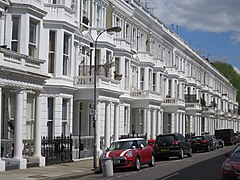 Perham Road, West Kensington | |
Location within Greater London | |
| OS grid reference | TQ246783 |
| London borough | |
| Ceremonial county | Greater London |
| Region | |
| Country | England |
| Sovereign state | United Kingdom |
| Post town | LONDON |
| Postcode district | W14 |
| Dialling code | 020 |
| Police | Metropolitan |
| Fire | London |
| Ambulance | London |
| UK Parliament | |
| London Assembly | |
West Kensington, formerly
It is predominantly a dense residential area with the
Name
"West Kensington" is an early marketing construct, a ploy by two Victorian developers who found they had trouble selling their rapidly erected estate of terraced housing in the hamlet of North End on the outskirts of the village of Walham Green. In 1876 William Henry Gibbs and John P. Flew, builders from Dorset, decided to capitalise on their modest success in Kensington, by speculatively building 1,200 houses on the market gardens west of the West London Railway in Fulham. However, the housing slump of the 1880s left them with many unsold properties. They succeeded in persuading the Metropolitan Borough of Fulham to have North End renamed 'West Kensington' to attract new investors to their empty houses.[1]
History

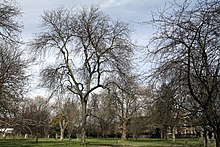

From the
The quiet of North End was sorely disturbed from 1824 onwards when local landowner William Edwardes, 2nd Baron Kensington, along with several others, decided to cash in on the already waning canal boom by converting a section of Counter's Creek into the Kensington Canal.[2][3] It was not a success. Eventually the canal was filled in, and in mid 19th century it became a railway and the creek was turned into a sewer. With it came gradual urbanisation, which drew in various developers including Gibbs and Flew. Apart from their unsold houses, there was the problem of accessibility. A bridge was needed over the railways, but despite Gibbs and Flew trying to finance it, it led to their bankruptcy and the dissolution of the partnership in 1885. Gibbs and Flew thereafter carried on separate businesses with a measure of success in Fulham.[4]
Barons Court
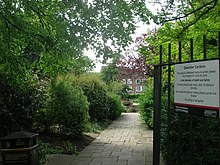
Another local landowner and developer in the 19th century was the Irish-born politician Sir William Palliser. It is possible that the station built on Palliser's land and opened in 1874, was named after the Irish estate of the Earls of Abercorn, Baronscourt in County Tyrone where Palliser may have had connections.[5] As well as Palliser Road itself, a group of roads in West Kensington are named after members of his family. They include: Perham, Charleville, Gledstanes, Barton, Fairholme, Comeragh, Castletown and Vereker Roads and Challoner Street. He also owned the 11 acres (45,000 m2) which would become the Queen's Club. However, as he was heavily in debt when he died suddenly in 1882, his family did not benefit from his deals.[6]
A contemporary of Palliser was Sir Robert Gunter whose family also left its mark on a number of streets that were built on his North End estate. They are Gunterstone Road, Edith Road and Edith Villas in memory of his daughter who died of scarlet fever, aged eight. After the severe bomb and landmine damage to the area during World War II, the Gunter estate donated Gwendwr Gardens, formerly the Cedars Lawn Tennis Club, to the public as a memorial to those who had perished.[7]
Other developments

The railway developments at North End included the Lillie Bridge Depot, an important historic engineering workshop with secondary access from Beaumont Avenue since 1872. The
The campaign for a bridge into West Kensington from nearby Earl's Court was taken up by local residents and the West Cromwell Road bridge was eventually commenced in 1938 and, interrupted by World War II, was opened in 1942.[12]
Housing stock

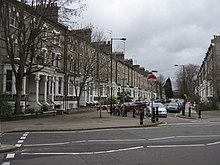
West Kensington is primarily a residential area consisting mainly of
Since much of the housing is in the rented sector, West Kensington has become a cosmopolitan enclave. There are significant populations of Arabs, Americans, Australians, New Zealanders, Irish, Italians, Spaniards, and French, encouraged by nearby private schools teaching in their native language can be found around Brook Green. The area also has a large student population, serving Imperial College London, Charing Cross Hospital, South Kensington, Hammersmith and other Central London Universities.
Avonmore Road. built in the 1880s, has been dubbed "Kensington Village". Whiteleys Furniture Repositories, laundry and stables, built along the West London line, belonged to London's first department store in Westbourne Grove. The high-ceilinged Warwick Building was used as a depository for Whiteleys-sourced furnishings (grand pianos, chaise longues, oriental room dividers, mahogany wardrobes) for the use of customers who were resident in the colonies. Kensington Village now consists of a blend of modernised Victorian buildings, such as the Warwick Building, and modern additions such as the Pembroke Building, built in a similar style with London stock brick and red lintels and full-height glazing.
Commerce, education and religion

Local business consists of small shops, offices and restaurants, with the
In February 2009, the W14 postcode became the first London postal area without a post office, until a sub-post office agreement was reached with the retail outlet, North End News.[14]
Education
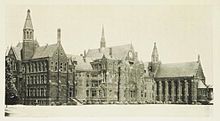
West Kensington once had on its fringes the dominating presence of a terracotta cluster of
Religion

Despite its name, the church of
West Kensington's main parish church, St Mary's, is located in Hammersmith Road, near the junction with Edith Road. The original church building was built in 1813 and given its own parish in 1836. In June 1944 the church building was completely destroyed by a V1 flying bomb. The present church building dates from the 1960s.[17]
In popular culture
Blythe House has been used as a filming location for numerous films including Tinker Tailor Soldier Spy.[18]
In the film Trainspotting, the flat that Renton shows the young couple around when he gets the job as an estate agent and ultimately stashes Begbie and Sickboy in is 78A North End Road, opposite West Kensington tube station.
The Nashville Rooms, now the Famous Three Kings pub, hosted many rock and punk concerts in the 1970s and early 1980s.
In Hanif Kureishi's novel The Buddha of Suburbia, the main character moves from the southern suburbs of London to West Kensington and lives by the Nashville. He witnesses one of the first presentations of a punk band, probably The Sex Pistols.
The flat featured in the 1969 BBC series 'Take Three Girls' was at 17 Glazbury Road.
The 2005 Woody Allen film Match Point was shot on location at Queen's Club and in the surrounding residential streets.
Notable people
- Edward and Georgiana Burne-Jones, he a Pre-Raphaelite painter, she a writer, resided at the Grange, in what is now the Lytton Estate, West Kensington.[20]
- John Melhuish Strudwick, Pre-Raphaelite painter, resided at Edith Villas during the 1880s and into the 1890s.
- Maude Goodman a.k.a. Matilda Scanes, artist, resided at Edith Villas until 1894, and then 7 Addison Crescent until her death in 1938. From 1938 to 1968 the Maude Goodman Studio operated musical recitals there with Dame Eva Turner as president.[21]
- Edward Compton, actor-manager lived and died at 54 Avonmore Road.
- William Crathern, composer, was organist of St Mary's, West Kensington (at that time known as North End).[22]
- Edward Elgar, composer, lived at 51 Avonmore Road, W14, 1890–1891.
- Peg Entwistle, Broadway actress whose 1932 suicide from atop the Hollywood Sign forever tagged her as "The Hollywood Sign Girl", had her earliest childhood at 53 Comeragh Road.[23]
- Estelle, rapper, was born and raised in West Kensington; her song "1980" was written about growing up in the area.
- Charles James Feret, Fulham historian, editor of the Fulham Chronicle and author of Fulham Old and New (1900), lived in Edith Road.[24]
- Mahatma Gandhi, lived on 20 Barons Court Road (West Kensington) while studying law.
- Pan Africanist, founder of the Black Star Line shipping company and the Universal Negro Improvement Association and African Communities League, lived and died in West Kensington.

- Adolphe and Léon, horn and oboe players respectively, lived at 70, Edith Road West. A blue plaquecommemorates them.
- Sir Robert Gunter was a Yorkshire and Chelsea-based member of the wealthy landowning confectioners, the Gunter family, who developed large swathes of West London. Street names like Gunterstone and Edith commemorate Gunter family members.
- Shewhile there.
- Adelaide Hall Jazz singer and entertainer lived at 54A Fairholme Road until her death in 1993.
- Stephen Hester, chief executive, Royal Bank of Scotland[citation needed]
- James Hunt, Formula 1 champion, lived in Normand Mews, 1980–82.[25]
- James MacLaren, architect, designed 22 and 22A Avonmore Road for sculptor HR Pinker.[26]
- Stirling Moss, British former Formula One racing driver, was born in West Kensington in 1929
- Sir William Palliser, Irish-born conservative politician who built several terraced streets in North End.
- Mary Ann Sieghart writer, broadcaster and assistant editor of The Times was born in the area.
- Sir John Tenniel (1820–1914), artist and cartoonist, lived at 52 FitzGeorge Avenue, West Kensington until his death on 25 February 1914.[27]
- William Worby Beaumont (1848-1929), engineer and inventor, lived at 76 Gunterstone Road.[28] The local Beaumont Avenue is a memorial to him.
- William Butler Yeats lived in Edith Villas with his family in 1867.[29]
Transport

West Kensington is well served by public transport.
- There are three London Underground stations:
- West Kensington (District line)
- Barons Court (District and Piccadilly lines)
- Kensington (Olympia) (District line and London Overground)
- There are seven more in the vicinity:
- Hammersmith (District and Piccadilly lines)
- Hammersmith (Circle and Hammersmith & City line lines)
- Earl's Court (District and Piccadilly lines)
- High Street Kensington (District line)
- Fulham Broadway (District line)
- West Brompton (District and London Overground)
- Gloucester Road (District, Circle and Piccadilly lines)
- Goldhawk Road (Hammersmith & City and Circle lines)
- Shepherd's Bush (Central and Hammersmith & City lines)
- Overground: The London Overground is available from West Brompton station, Kensington (Olympia) station and Shepherd's Bush.
- Bus: Several Bus routes are available in the area including the West Middlesex Hospital.
- Road: West Kensington is also close to the A4 (West Cromwell Road) with links to the West and Heathrow and High Street Kensington with links to the Central London/West End.
A local transport-related curiosity (and not open to the public) is the London Underground training centre that contains a mock-up station called
Nearest locations and places of interest

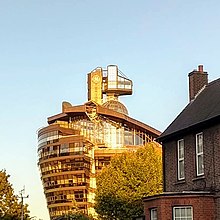
- Queen's Club – home to The Queen's Club Championships
- Olympia Exhibition Centre
- Margravine Cemetery, a green space in the area
- The Ark, London, a notable ship-shaped office block
- Olympia
- Commonwealth Institute in Kensington High Street
- Lyric Theatre (Hammersmith)
- Riverside Studios, an arts centre re-opened by the Thames at Hammersmith
- Hammersmith Bridge
- Kelmscott House at 26 the Mall, Hammersmith, home of artist William Morris
- Blythe House stores and off-site facilities for Victoria & Albert, Science and British Museums
- North End Road Market
- Charing Cross Hospital
- Kensington High Street
- Holland Park
- Fulham Broadway
- Hammersmith Broadway
- Hammersmith Apollo
- Westfield London
Future redevelopment
The
There was strong local and international opposition to the project which put thousands of people's homes, employment and businesses at permanent risk.
Terrorism incident
On 26 February 1975, Stephen Tibble, a 22 year old police officer of the
References
- ^ 'The Edwardes estate: Warwick Road (north) and West Cromwell Road', in Survey of London: Volume 42, Kensington Square To Earl's Court, ed. Hermione Hobhouse (London, 1986), pp. 282-288. British History Online http://www.british-history.ac.uk/survey-london/vol42/pp282-288 [accessed 20 October 2016].
- ^ British History Online, The Kensington Canal, railways and related developments, The Institute of Historical Research and the History of Parliament Trust, online at [1]
- ^ Deposited plans, House of Lords Records Office, quoted in British History Online
- ISBN 0-948667-43-5.
- ^ Museum of London caption to Barons Court station image
- ISBN 978-1-4050-4924-5.
- ISBN 0-948667-43-5.
- ^ Arthur Lloyd. "Empress Theatre/Hall". Retrieved 24 January 2017.
- ^ "Empire of India Exhibition, 1895". The Open University. Retrieved 13 December 2014.
- doi:10.1093/ref:odnb/53347. Retrieved 27 January 2014. (Subscription or UK public library membershiprequired.)
- ^ "Imre Kiralfy Dead in England" (PDF). New York Times. 29 April 1919. Retrieved 13 December 2014.
- ISBN 0-948667-43-5.
- ^ Thring, Oliver (17 March 2010). "Fancy a Polish?". The Guardian.
- ^ Campaigners put post office back on the map in Olympia
- ^ Fulham Boys School finally finds temporary home in West Kensington getwestlondon.co.uk
- ^ Hoggart, Paul (10 July 2017). "Backstage: Why Lamda's £28 million extension is making jaws drop". The Stage.
- ^ "Saint Mary, West Kensington". London Metropolitan Archives. Retrieved 7 September 2021.
- ^ Tinker Tailor Soldier Spy film locations
- ^ Daily Brendan Gunn – Dialogue Coach Article
- ^ Melbury Road, Leighton House, and the Holland Park Artists' Houses
- JSTOR 952044.
- ^ The Elgar Trail
- ^ The Hollywood Sign Girl Archived 10 February 2012 at the Wayback Machine
- ^ Féret, Charles (1900). Fulham Old and New, vol.I-III (PDF). Vol. III. Leadenhall Press.
- ^ Telegraph Article "Colourful Past" Nos 7&8 Normand Mews
- ^ Olympia and Avonmore Character profile, London Borough of Hammersmith & Fulham Archived 27 September 2007 at the Wayback Machine
- ^ L. Perry Curtis Jr, "Tenniel, Sir John (1820–1914)" Retrieved 25 February 2014, pay-walled.
- ^ England & Wales, National Probate Calendar (Index of Wills and Administrations), 1858-1995 for William Worby Beaumont (1929)
- ^ New York Times WB Yeats "A Life"
- ^ "News from Darren Johnson AM: Mayor urged to refuse Earl's Court planning application | Greater London Authority". London.gov.uk. 5 March 2013. Archived from the original on 23 April 2013. Retrieved 15 January 2014.
- ^ "Save Earl's Court! – Home". Saveearlscourt.com. Retrieved 15 January 2014.
- ^ Hill, Dave (26 November 2012). "Earls Court: Kensington and Chelsea's go ahead can't hide the contradictions". The Guardian. Retrieved 15 January 2014.
- ^ Megan Kelly (18 November 2019). "Capco sells Earls Court estate for £425m". Construction News. Retrieved 28 November 2019.
- ^ "BBC ON THIS DAY | 27 | 1975: PC murder linked to IRA bomb factory". BBC News. 27 February 2002. Retrieved 9 April 2017.



